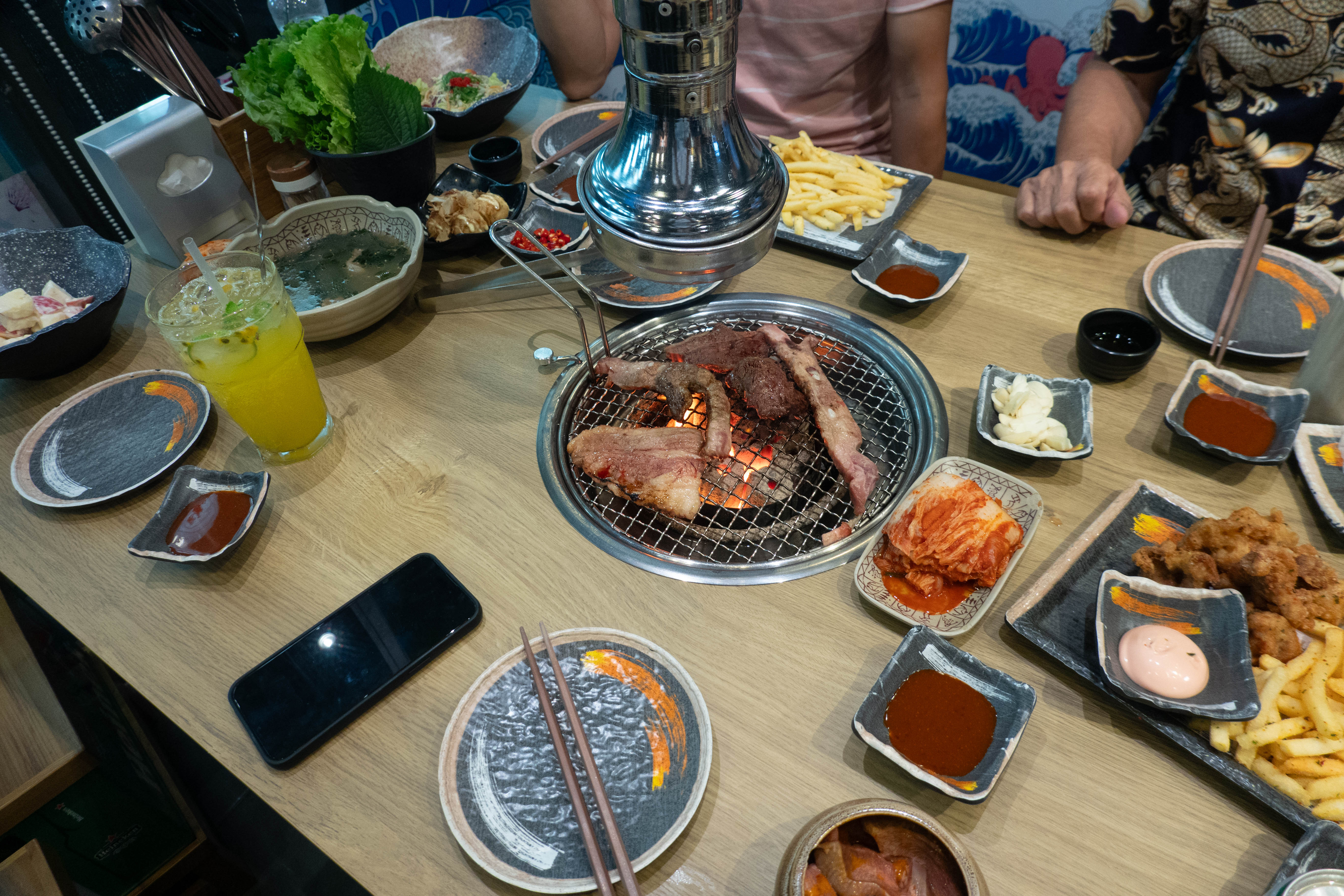Page 8

7/28/2023
Today I thought I'd share some things I learned about table manners and the food here in Vietnam.
Culinary observation #1
If you ever have the opportunity to come to Vietnam, be careful how you chew. With only three exceptions I can think of (phở gà [chicken noodle soup], phở bò [beef noodle soup], bún chả [grilled pork and noodles], and bánh mì [a sort of sub sandwich with a variety of fillings]), the Vietnamese DO NOT de-bone any animal or fish. They just take a big cleaver, or a pair of kitchen scissors, and chop/cut whatever it is into pieces and cook it. When it's cooked, before serving, they will use kitchen scissors and cut it again into small-ish bite-size-ish servings. In the picture above, once the meat is cooked, it will be cut with kitchen scissors into smaller pieces. In the picture above, the two white dots/smudges in the long narrow piece of pork, on the right side of the grill, are pieces of rib bone.
Culinary observation #2
When preparing shrimp dishes, the Vietnamese do not shell them, de-vein them, or remove the head or legs. When eating shrimp, after it has been cooked and placed on the table, the Vietnamese will generally (but not always) only remove the head and legs. They will consume everything else, including the shell (or head and legs if still attached). That is, they just place the headless/legless (or not) shrimp into their mouth or bite off a piece of the giant shrimp the have here (4-5" long) and chew away! I’ll admit, it took me a bit to get use to the crunch.
Culinary observation #3
I’d say my impression of Vietnamese cuisine is that texture is very important. Every dish and meal seems to be constructed to contain layers of different textures. For example dishes that have tripe, entrails, snail, or seafood (e.g., shrimp, octopus, squid), which are very crunchy, will be mixed in with leafy greens. Meat of any kind will be what we’d call “tough” - “tender” means the animal was not “healthy because it was lazy, didn't move around much, and therefore didn’t develop strong muscles”…or so I’ve been told. Meat dishes will generally have greens mixed in. Tofu is soft and smooth and will be boiled or deep fried and eaten alone or in a soup with fish. Fish is firm, but can be served breaded for a crunch or in a soup with crunchy veggies, or tofu, or both, or all, or with noodles, or not. Whole fish can also be gutted and grilled with the head on, boiled in a soup, or cut up and fried. Veggies can be cooked or boiled to be crisp or mushy. They can also be eaten raw. Greens can be leafy or stringy and can be fried, boiled, raw, or battered.
Culinary observation #4
Vietnamese meals at restaurants are served in courses. When you are invited to lunch or dinner by friends, they will pay for your meal (whoever invites pays) and they will order the food for you or ask you what you wish to eat. Do not mistakenly fill up on what they bring to the table first. It will be followed by one to two additional courses and a desert. Usually, in my experience, in this order: meat dishes served first, vegetable dishes second, and a hot pot dish third. Then, of course, desert.
Culinary observation #5
At a restaurant, you don’t get free water placed on the table like you do in the US. If you don’t order water or a drink, you won’t have a drink with your meal. To my knowledge wait people don't come to your table and ask you what you want to order. When you are ready, you call them over to your table ("Em ơi!" ["Hey!"]) and tell them what food and beverage you want to have brought to your table.
Generally when a group goes out for a meal, drinks will be ordered for all, and placed on the table in unopened containers. At a street food cafe, you will get free tea without asking.
Etiquette for bottled drinks is as follows: If everyone is drinking the same thing, let's say water (nước), someone will open a bottle and poor about a quarter of a glass into everyone's glass. Glasses are never filled to the brim, and you won't get your own bottle…unless you are drinking something different; but you still follow the quarter glass rule. People will keep restoring your quarter glass for you.
At a bia hơi, if you are drinking domestic beer with your meal (or just drinking domestic beer), a crate of full, unopened bottles will be placed by your table. The person next to the crate does the dispensing, following the quarter glass rule. At the end, when you pay for your meal, empty beer bottles are counted and you are charged accordingly. If you are drinking bia hơi, you will get a full glass, and the waitperson will bring you a new glass when your glass is empty…until you tell them to stop. You can also order bia hơi by the pitcher full. If you order by the pitcher, you pour no more than a half glass for everyone. Although cold beer is frequently brought to the table, given the heat, it never stays cold. This means you learn to drink warm beer, or you learn to drink beer with ice cubes in it.